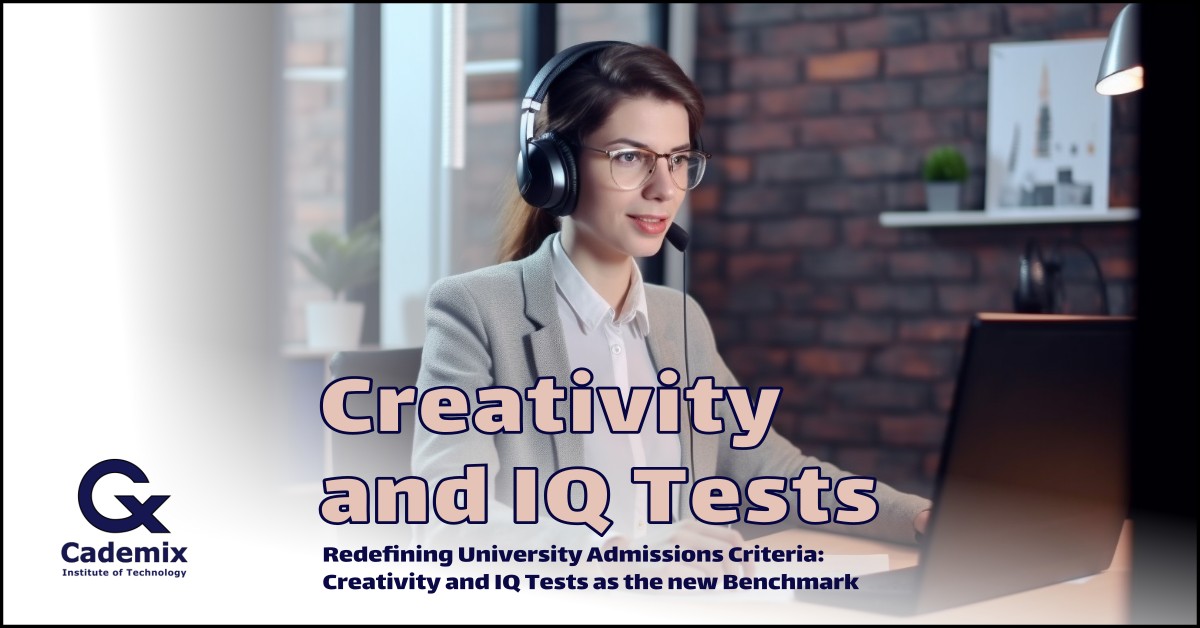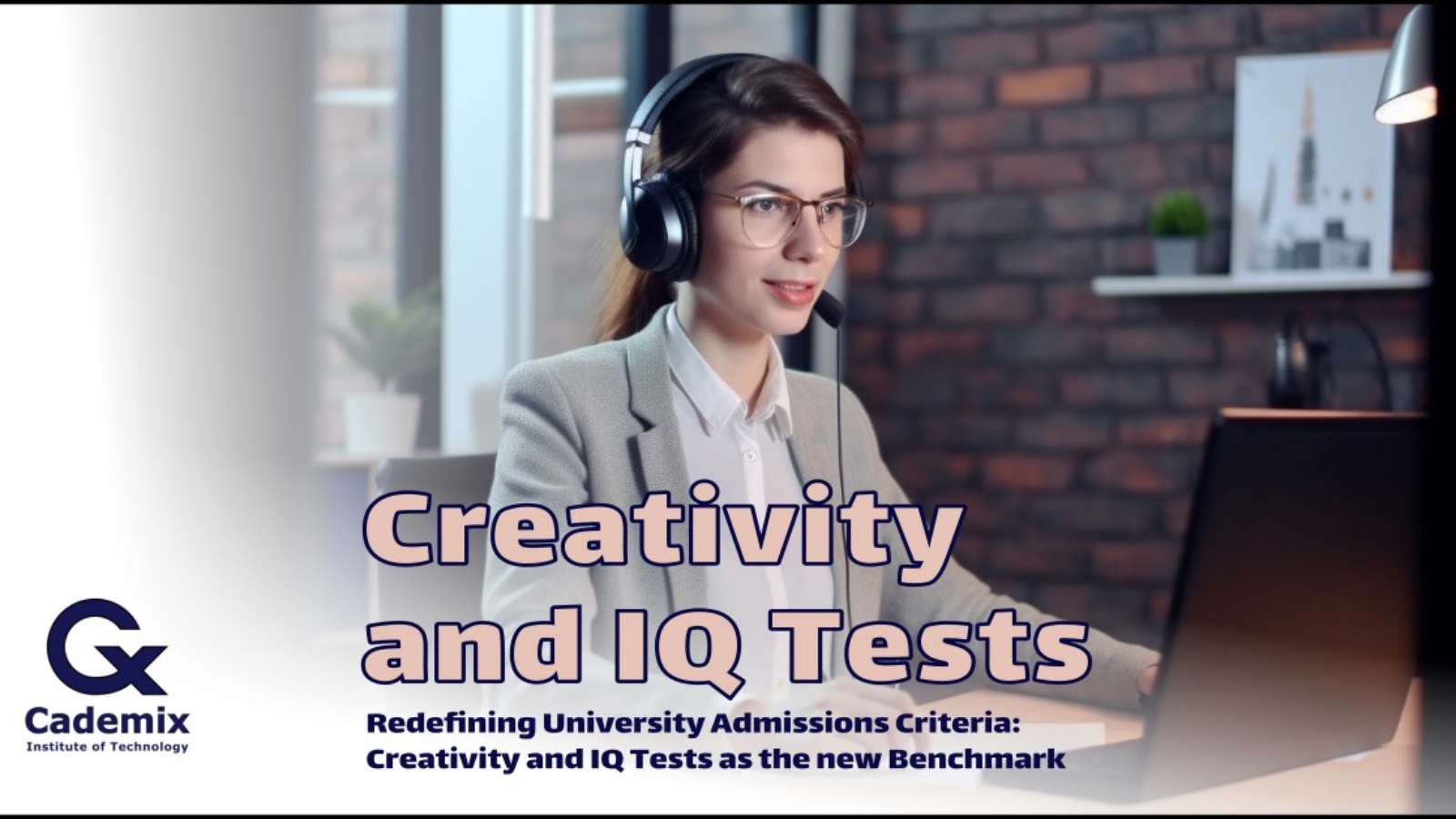Redefining University Admissions Criteria: Creativity and IQ Tests as the New Benchmark explores the growing trend of using Creativity and IQ Tests for University Admissions to evaluate international students. This article delves into the challenges of traditional admissions criteria, the rise and importance of these tests, their implementation in various fields, and tips for preparing and excelling in these new assessment methods.
Introduction
Higher education has evolved, and universities now look for new ways to assess students. Creativity and IQ Tests for University Admissions have emerged as a crucial component in this process. These tests enable universities to evaluate students from diverse backgrounds fairly and effectively.
This article aims to provide insight into the growing importance of Creativity and IQ Tests for University Admissions. It offers an overview of the challenges traditional admissions criteria face and highlights the benefits of these innovative tests. Furthermore, the article serves as a guide to help applicants prepare for and excel in this new admissions landscape.
Creativity and IQ Tests for University Admissions are increasingly popular, particularly in fields like art, social sciences, management, marketing, and design. These tests allow universities to assess intellectual abilities beyond technical skills, ensuring that they select the best-suited candidates for their programs. As the trend continues to grow, it is essential for students to familiarize themselves with these tests to maximize their chances of success in the admissions process.

Challenges in Traditional Admissions Criteria
GPA and university quality issues
Traditional admissions criteria often rely heavily on GPA and the reputation of an applicant’s previous university. However, these factors may not accurately reflect a student’s true potential. Different grading systems and educational standards across the world can make it difficult to compare candidates fairly using these metrics alone.
Artificial intelligence and document fraud
The rise of AI has made it easier for applicants to manipulate their credentials, creating a growing concern for universities. With the increasing prevalence of document fraud, universities face the challenge of verifying the authenticity of submitted documents. Creativity and IQ Tests for University Admissions can help address this issue by providing a more reliable and objective way of assessing candidates.
The role of career counselors
Professional career counselors play an essential role in guiding students through the admissions process. However, some counselors may submit documents or information on behalf of applicants without their knowledge. Apart from the fact that it is illegal, this practice can lead to misrepresentation of the candidates, further complicating the university’s task of selecting the best-suited students. By implementing Creativity and IQ Tests for University Admissions, institutions can better evaluate each applicant’s intellectual abilities, reducing the reliance on potentially unreliable documentation.

The Rise of Creativity and IQ Tests
Importance in various fields
Creativity and IQ Tests for University Admissions have gained popularity across numerous disciplines, including art, social sciences, management, marketing, and design. These tests allow universities to assess candidates’ intellectual capabilities beyond their technical skills. As a result, institutions can make more informed decisions when selecting students who are most likely to succeed in their programs.
Integration with online interviews
With advancements in technology, universities have started integrating Creativity and IQ Tests into their online interview process. Candidates can log into virtual meetings, such as Skype or Microsoft Teams, and participate in a monitored and recorded session. These virtual tests enable universities to evaluate applicants from around the world, ensuring a fair and efficient admissions process.
Test format and examples of Creativity and IQ Tests for University Admissions
Creativity and IQ Tests for University Admissions can take various forms, including multiple-choice questions, written exams, or even drawing and performance-based tasks. In fields like art and music, candidates may be asked to create a drawing or perform a piece of music within a specified time. These tests help institutions assess each applicant’s unique abilities and potential, providing a more comprehensive evaluation than traditional admissions criteria.
Time-limited exercises:
Creativity and IQ tests often include time-limited exercises designed to assess a candidate’s ability to think quickly and adapt to new situations. These time constraints simulate real-world scenarios where students must perform under pressure, providing universities with valuable insight into how applicants may handle challenging academic situations.
Problem-solving tasks:
Another common element in Creativity and IQ Tests for University Admissions is problem-solving tasks. These tasks require candidates to analyze complex problems and develop innovative solutions. By evaluating an applicant’s critical thinking and problem-solving skills, universities can better predict their potential for success in their chosen field of study.
Logical reasoning questions:
Logical reasoning questions test an applicant’s ability to identify patterns, draw conclusions, and make inferences. These types of questions measure a candidate’s analytical skills and help universities determine if they possess the intellectual aptitude necessary for their desired program.
Creativity-based assessments:
Creativity-based assessments within Creativity and IQ Tests for University Admissions evaluate a candidate’s ability to think outside the box and generate innovative ideas. These tests may include prompts that require applicants to produce unique solutions, encouraging them to showcase their creative thinking and originality.
Spatial reasoning tasks:
Spatial reasoning tasks are another common element in Creativity and IQ tests. These tasks require candidates to visualize and manipulate objects in their minds, demonstrating their spatial intelligence. Spatial reasoning skills are especially important for students pursuing fields such as engineering, architecture, and design.
Verbal and quantitative reasoning:
Verbal and quantitative reasoning questions assess a candidate’s language and numerical skills. These types of questions help universities gauge an applicant’s command of language and ability to work with numbers, which are essential skills for success in many academic programs.
Adaptability and flexibility:
Creativity and IQ Tests for University Admissions may also include tasks designed to assess a candidate’s adaptability and flexibility. These tasks might require applicants to change their approach or consider new perspectives, allowing universities to evaluate how well a candidate can adjust to new information or challenging situations.
Cultural and ethical awareness:
Some tests may also incorporate questions that evaluate a candidate’s cultural and ethical awareness. These questions can reveal a candidate’s understanding of diverse perspectives, values, and beliefs, which is increasingly important in today’s globalized world. Also by including various assessment methods in their Creativity and IQ Tests for University Admissions, universities can better select well-rounded candidates who are likely to succeed in their programs and contribute positively to the campus community.
Group exercises:
Some Creativity and IQ Tests for University Admissions may involve group exercises to evaluate an applicant’s teamwork and communication skills. These exercises can also reveal how well a candidate collaborates with others, which is an essential skill for success in many academic programs and professional environments. Further, by incorporating various test formats and examples, universities can obtain a comprehensive understanding of a candidate’s abilities, ensuring a more accurate and reliable admissions process.
Preparing for Creativity and IQ Tests
Tips and strategies:
To excel in Creativity and IQ Tests for University Admissions, applicants should familiarize themselves with the types of questions and tasks they may encounter. Further, this can include practicing problem-solving, logical reasoning, and creativity-based exercises. Candidates should also work on improving their time management skills to ensure they can efficiently tackle time-limited tasks.
Simulation exams and interview practice:
Taking simulation exams and participating in mock interviews can be highly beneficial for serious candidates. Further, these practice sessions help applicants become more comfortable with the test format and interview process, allowing them to perform better under pressure. Additionally, simulation exams can provide valuable feedback on areas where improvement is needed.
The role of mentors and programs
Mentors and specialized programs, such as those offered by the Cademix Institute of Technology, can provide invaluable guidance and support for applicants preparing for Creativity and IQ Tests for University Admissions. Also these programs often include exam simulations, interview coaching, and personalized feedback to help candidates maximize their chances of success. In addition, by working with experienced mentors, applicants can develop a deeper understanding of the test requirements and improve their performance in these critical assessments.

20 Tips before Creativity and IQ Tests for University Admissions
- Research the university’s website thoroughly to understand their expectations and requirements.
- Study the curriculum of the courses you are applying for to gain a deeper understanding of the program.
- Investigate the backgrounds of lecturers, professors, and interviewers to gain insights into their focus topics.
- Practice sample IQ and creativity tests to familiarize yourself with the test format and question types.
- Compile a list of potential questions and prepare well-structured answers for them.
- Gather necessary stationery materials, such as pens, pencils, paper, and erasers.
- Have a calculator ready for any quantitative tasks that may be included in the test.
- Practice time management by taking timed practice tests to become more efficient in answering questions.
- Develop a study schedule that allows ample time for preparation and review.
- Seek feedback from peers, mentors, or teachers to identify areas for improvement.
- Engage in mental exercises, such as meditation or mindfulness, to enhance focus and concentration.
- Maintain a healthy sleep schedule, especially in the days leading up to the exam.
- Stay updated on current affairs and relevant topics in your field of study.
- Participate in group discussions or debates to improve your communication and critical thinking skills.
- Familiarize yourself with the interview platform (e.g., Skype or Microsoft Teams) to ensure a smooth experience.
- Practice stress-management techniques, such as deep breathing or visualization, to remain calm during the exam.
- Review your past academic work, projects, and accomplishments to showcase your skills and experiences.
- Create a quiet and comfortable study space, free from distractions, to optimize your preparation time.
- Set achievable goals for your preparation and track your progress to stay motivated.
- Maintain a positive attitude and believe in your ability to succeed in the Creativity and IQ Tests for University Admissions.
Examples of IQ Tests during University Entrance Exam:
- Question: In a creative design team, there are 4 graphic designers, 3 web developers, and 2 project managers. If a new project requires 2 graphic designers, 1 web developer, and 1 project manager, how many different team combinations can be formed?
Answer: There are 6 different team combinations.
- Question: Find the next shape in the following sequence: Circle, Triangle, Square, Pentagon, _____
Answer: Hexagon.
- Question: In an art gallery, there are 3 times as many paintings as sculptures. If there are 12 sculptures, then how many paintings are there?
Answer: There are 36 paintings.
- Question: A product development team has 30 days to complete a project. If the team completes 50% of the project in the first 10 days, how many days will it will then take to finish the remaining 50% if they work at the same pace?
Answer: It will take 20 more days.
- Question: In a management hierarchy, there are 3 managers, each supervising 4 team leaders. Further each team leader is responsible for 5 team members, including himself/herself. How many people are in the organization, including managers, team leaders, and team members?
Answer: There are 63 people in the organization.
Examples of Creativity Tests during University Entrance Exam:
- Design a unique logo for an eco-friendly fashion brand within 5 minutes, using only three colors.
- Write a short and creative tagline for a new smartphone app that helps users find local events and activities.
- Sketch a concept for an eye-catching billboard advertisement promoting a new line of sports shoes.
- Briefly describe an innovative marketing campaign for a start-up that offers online art classes for beginners.
- Create a catchy name for a new environmentally-friendly cleaning product and provide a brief explanation for your choice.
- Imagine a new type of packaging for a popular snack food that minimizes waste and is easy to use. Sketch the design and explain its benefits.
- Write a short and persuasive pitch for a new social media platform targeting creative professionals.
- Design a simple and visually appealing poster to raise awareness about the importance of recycling in a community.
- Develop a creative idea for a promotional event to attract customers to a new coffee shop in a busy city center.
- Propose an inventive loyalty program for a small boutique store that encourages repeat customers and stands out from competitors.
Conclusion on Creativity and IQ Tests for University Admissions
Implications for universities and candidates:
The use of Creativity and IQ Tests impacts both universities and candidates. Universities specifically benefit from a more reliable selection process. Hence, candidates have a chance to showcase their intellectual abilities, and this goes beyond their academic records.
The future of admissions processes:
The admissions process will continue to evolve, and therefore the creativity and IQ Tests may play a more significant role. They help institutions face challenges such as document fraud and diverse applicant backgrounds. By focusing on intellectual aptitude, universities identify top candidates.
Final thoughts and recommendations:
In conclusion, Creativity and IQ Tests can revolutionize university admissions. Candidates should also prepare by learning the test format. They should also practice sample questions. Seeking guidance from mentors or programs is helpful, and therefore this preparation increases their chances of success.
By embracing these new benchmarks, universities benefit. They can also create a more diverse student body. This benefits both the institutions and students. Therefore preparing well for these tests is not only crucial, rather it ensures applicants secure a place at their desired university.

